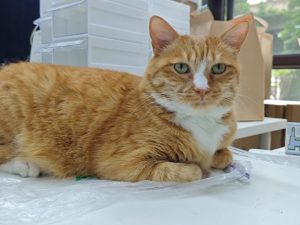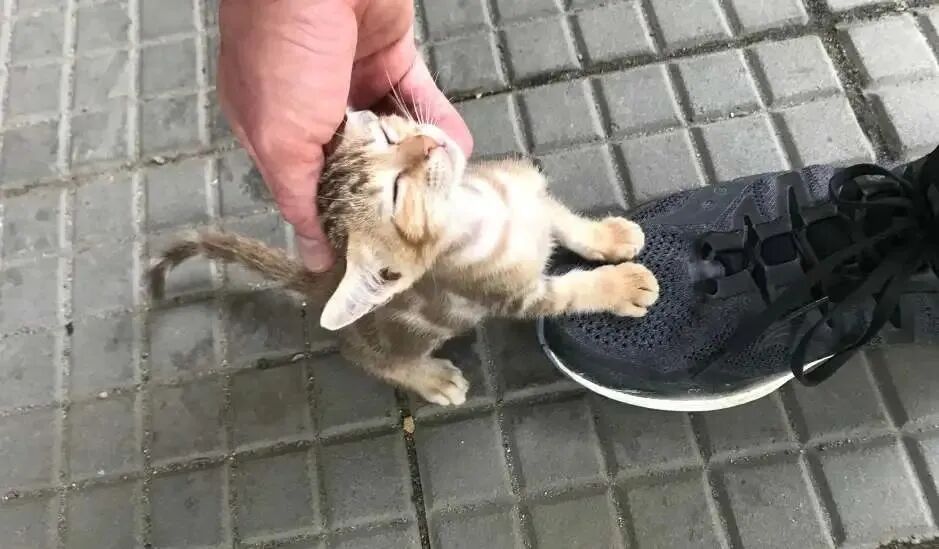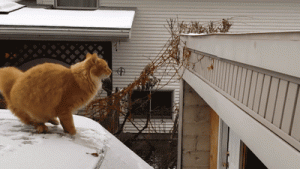When a cat is forcibly held and its body goes stiff, not daring to struggle,some owners might think, “Wow, my cat is so obedient!”But this could actually be a sign of the cat’s overly people-pleasing behavior caused by a lack of security.The essence of this behavior isn’t trust—it’s passive compliance under stress.The cat endures the situation to feel safe,but in doing so, it reveals inner anxiety.
-
What Are the Signs of a “People-Pleasing Cat”?
① Tense but Not Struggling When Held
When a cat is held or touched in an uncomfortable spot, it may appear visibly tense—dilated pupils, stiff muscles, tail pressed close to the body—but refrain from struggling or escaping.This “false compliance” may result from a physiological freeze response triggered by fear; the cat may know resistance is futile; or it may avoid displeasing you to prevent losing privileges (like access to food, being scolded, or restricted freedom).
② Excessive Grooming After Being Stopped
When a cat’s actions are interrupted, it may stop obediently yet start grooming itself frantically to relieve stress.For example, a cat might feel pressure and want to mark your clothes with urine (your scent is familiar and comforting) or pursue other needs like climbing, running, or scratching.Even if the behavior is interrupted, the physiological drive remains unresolved, so the cat turns to silent self-grooming to manage anxiety.
③ Seeking Interaction but with Blurred Boundaries
Most cats maintain a “safe distance.” For instance, a stray may enjoy being watched from 2 meters away but hiss if approached within 1 meter; another may allow head pets but kick if the belly is touched.Some cats seem to lack clear boundaries—they’re assessing situations, weighing risks and rewards, or adapting to new rules.For example, newly adopted strays may sometimes allow belly rubs but refuse at other times; a usually aloof kitten at home may stick closely to you at the vet.
-
These Behaviors Stem from Distrust and Compromise
If a cat frequently behaves this way, it may still lack trust in its environment or in you.Past experiences—being abandoned, early separation from the mother, the arrival of new household members (humans or animals), or unstable resources (irregular feeding, inconsistent attention)—can lead to over-dependence or confusion, prompting the cat to “people-please” in exchange for stability.However, if such behavior is occasional and context-specific, it actually indicates a sense of security and trust.For example, a cat may allow handling at the vet but firmly sets boundaries at home.Therefore, when observing people-pleasing behaviors, distinguish between temporary and long-term patterns.

-
Seven Signs of a Cat’s Trust in People (or Environment)
① Exposing the Belly at Home – Revealing the most vulnerable area shows trust.
② Sleeping Close to You – Indicates your surroundings are completely safe.
③ Gifting or Bringing Items to You – Shows the cat considers you part of its family, sharing resources and inviting you to “co-parent.”
④ Tucking Paws In – Signifies trust in the environment; the cat feels no need to respond immediately to potential threats.
⑤ Slow Blinking at You – A familiar, trusting greeting.
⑥ Licking or Rubbing Against You – Marks you as a roommate or member of the cat group, grooming and scent-marking.
⑦ Showing the Rear – Indicates no need to hide its scent; the cat trusts you completely, even sharing information about its diet, health, and emotions via anal glands and pheromones. -
Scientific Strategies to Rebuild a Sense of Security
① Give Cats Choice and Preparation in Interaction.Avoid forced hugs. Instead, extend a finger and let the cat choose to engage.If the cat rubs against your hand, gently stroke the head and neck. Stop immediately if signs of discomfort appear (tail flicking, flattened ears).
② Provide a “Safe Space”.Create hiding spots like boxes or cat trees, giving the cat a private area.Once inside, avoid picking up, restricting, or forcing interactions.
③ Set Consistent Routines for Interaction and Feeding.Regular feeding times, play sessions, and grooming help the cat feel in control and secure.
④ Use Positive Reinforcement for Desensitization.When performing necessary tasks like nail trims, employ encouragement, gentle stroking, and treats.This builds positive associations and strengthens trust.
⑤ Be Patient and Give Time.Trust develops gradually, step by step. Daily small actions accumulate into a strong bond, so owners must remain patient and consistent.
A cat’s excessive people-pleasing is a sign of a lack of trust.True security comes from respecting the cat’s boundaries:allowing it to say no to hugs and accepting occasional distance.When a cat can purr contentedly and expose its belly beside you—rather than trembling and pretending to be the “perfect little pet”—that may be the true proof of belonging.





